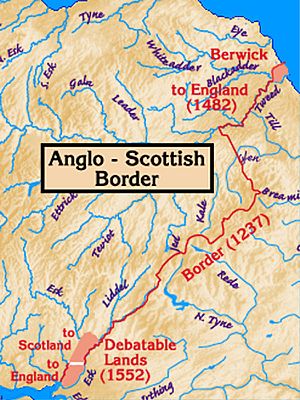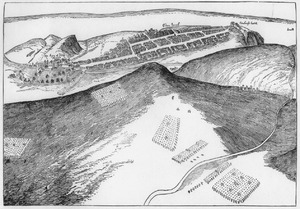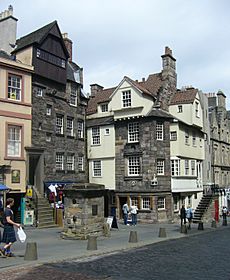Rough Wooing facts for kids
Quick facts for kids Rough Wooing |
|||||||
|---|---|---|---|---|---|---|---|
| Part of the Italian War of 1542–1546 and the Anglo-Scottish Wars | |||||||
 Anglo-Scottish border at the time of the Rough Wooing |
|||||||
|
|||||||
| Belligerents | |||||||
| Commanders and leaders | |||||||
The Rough Wooing was a series of wars between England and Scotland in the 1540s. It was part of the larger Anglo-Scottish Wars. England attacked Scotland for several reasons. King Henry VIII wanted to force Scotland to agree to a marriage between his young son, Edward, and the infant Scottish Queen, Mary, Queen of Scots. This would have united the two kingdoms.
England also wanted to break the "Auld Alliance" between Scotland and France. This alliance meant France could use Scotland as a base to attack England. The war also aimed to weaken Scotland. After Henry VIII died, his son Edward VI continued the war. The conflict finally ended in 1551. It was the last major war between Scotland and England before they were united under one crown in 1603.
Contents
What's in a Name?
In Scotland, people at the time called this war the "Eight Years' War" or "Nine Years' War." The name "Rough Wooing" became popular much later. It was used by writer Sir Walter Scott in the 1800s. He used this name to make the harsh war sound a bit less serious.
The phrase "Rough Wooing" comes from a famous quote. A Scottish leader, George Gordon, 4th Earl of Huntly, supposedly said: "We liked not the manner of the wooing, and we could not stoop to being bullied into love." This shows that Scotland did not want to be forced into an alliance with England.
Historians today use the name "Rough Wooing" to describe how brutal the war was. It involved a lot of destruction and violence.
From Solway Moss to Ancrum Moor
In November 1542, the Scottish army lost badly at the Battle of Solway Moss. Soon after, King James V died. His daughter, Mary, Queen of Scots, was only six days old when she became queen. England proposed a marriage between Mary and Prince Edward. This was agreed to in the Treaty of Greenwich.
However, the Scottish government, led by Regent Arran, was slow to make the marriage happen. Many Scottish nobles preferred their old alliance with France. They also wanted to keep the Catholic religion in Scotland, while England had become Protestant.
An English diplomat, Ralph Sadler, reported what a Scottish official, Adam Otterburn, said: "Our people do not like of it... our common people do utterly mislike of it." Otterburn also asked, "if your lad was a lass, and our lass were a lad, would you then be so earnest in this matter?" This showed that Scots did not want an English king.
A group of Scottish nobles who favored France, led by Cardinal Beaton, opposed the marriage. They signed a "Secret Bond" against it. Young Queen Mary and her mother, Mary of Guise, were moved to Stirling Castle for safety. Scotland then faced anger from King Henry VIII. The Scottish Parliament officially rejected the Treaty of Greenwich in December 1543. Five days later, England declared war.
Major fighting began with an attack on Edinburgh in May 1544. The English army, led by the Earl of Hertford, landed near the city. Hertford had orders to burn Edinburgh. He was told to blame Cardinal Beaton for Scotland's refusal of the marriage.
The English army entered Edinburgh and set the city on fire. Edinburgh Castle defended itself with cannons. Hertford decided not to try to capture the castle but burned the city thoroughly. Many houses, including Holyroodhouse, were destroyed. The English ships took stolen goods and captured Scottish ships. The army then marched back to England, burning towns along the way.
After this attack, Scottish nobles like the Earl of Angus were released from prison. Even though they had supported the English marriage, Regent Arran now needed their help against the English invasion. English forces also raided across the border, burning homes and getting some Scots to switch sides. These Scots were called "assured men."
Despite these attacks, the Scots won a victory at the Battle of Ancrum Moor in February 1545. Scotland was included in a peace treaty in June 1546, which brought 18 months of peace. In May 1546, some Protestant Scottish nobles killed Cardinal Beaton at St Andrews Castle. They hoped for English support against Regent Arran.
From Pinkie to Peace
King Henry VIII died in January 1547. The war continued under Lord Protector Somerset, who ruled for the young King Edward VI.
The English built a fort at Langholm in the Scottish borders. The Scots captured it back in July 1547. At the same time, French ships helped the Scots take back St Andrews Castle from the Protestant nobles. Regent Arran ordered signal beacons to be set up along the coast. These "bailes" would warn of an English invasion by sea. Horsemen were ready to spread the news quickly.
A big English invasion in September 1547 led to a major battle at Pinkie, near Musselburgh. The English won, and much of southern Scotland came under English control. Haddington and Broughty Castle near Dundee were occupied by English forces.
French military help for Scotland increased. French engineers helped strengthen Edinburgh Castle and Dunbar. In June 1548, 10,000 French soldiers arrived in Scotland. They helped besiege Haddington, which was held by the English.
To keep her safe, Queen Mary was sent to France in August 1548. She was engaged to the French prince. With more money and soldiers from France, the Scots were able to keep fighting. The French also captured the island of Inchkeith in June 1549.
The End of the War
The English left Haddington on September 19, 1549. The fighting between England and Scotland ended with the Treaty of Boulogne on March 24, 1550. This treaty was mainly between France and England, but Scotland was included.
The peace treaty had several conditions:
- Prisoners were returned.
- Border forts were destroyed.
- The border lines went back to how they were before the war.
- Fishing rights on the River Tweed were returned to Scotland.
- All captives and hostages were sent home.
As part of the treaty, important people from France and England were exchanged as hostages for a short time. They were treated well and returned home a few months later.
In April 1550, a French official brought the peace treaty to Scotland. Mary of Guise and Regent Arran gave him a gold chain as a gift.
A separate peace treaty was needed between Scotland and the Holy Roman Empire to settle trade and piracy issues. This treaty was signed in May 1551. The Treaty of Norham in 1551 officially ended the war. All English soldiers left Scotland. In October 1551, Mary of Guise visited England and met King Edward VI.
Treaty of Norham
The peace treaty was signed at Norham Castle and a nearby church on June 10, 1551. Scottish and French representatives met with English representatives.
The main points of the treaty were:
- The English would leave all their forts in Scotland.
- The border between Scotland and England would go back to its original lines.
- Edrington and fishing rights on the River Tweed were returned to Scotland.
- All prisoners, pledges, and hostages were to be returned.
King Edward VI approved the treaty on June 30, and Queen Mary approved it on August 14, 1551.
The War of Words
Both sides used propaganda during the war. England wanted to convince Scots to support a union with England. They published books and pamphlets. These writings talked about England's old claims to rule Scotland. They also argued that Scotland was wrong to reject the marriage treaty. And they promoted the Protestant religion.
The English commander at Broughty Castle even hoped to give out Bibles printed in English, which were not common in Scotland.
Scotland fought back with its own propaganda. A book called Complaynt of Scotland was probably printed in France in 1549. It argued against the English claims.
One English writer, John Elder, wrote that Scottish lords in the north would be loyal to Henry VIII. He said they would reject the French culture that Cardinal Beaton and the Scottish court were bringing in.
After the Battle of Pinkie, Lord Protector Somerset published more English propaganda. These writings encouraged Scots to join an "honourable, Expedient & godly Union" with England.
Some Scots were convinced by the English. They signed agreements and took money from the English, becoming "assured men." This happened mostly in the border areas and around English forts. After the war, many Scots were accused of being "assured." For example, 192 people from Dundee were found not guilty in 1553.
By July 1549, the English were losing battles in France, and the "assured men" system stopped. One person wondered if it was better to win people's hearts without fighting, or to burn and build forts at great cost, which would never truly conquer Scotland.
After the war, the French celebrated their success in Scotland with big parties. In England, some English commanders had their portraits painted to show off their bravery.



